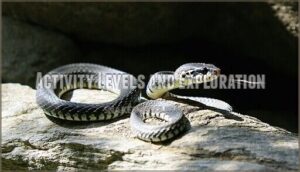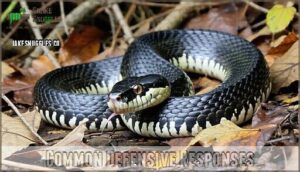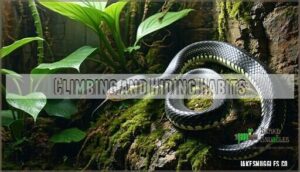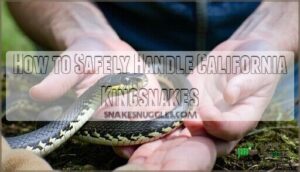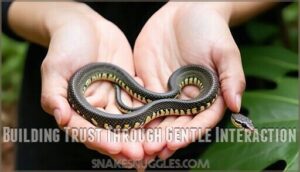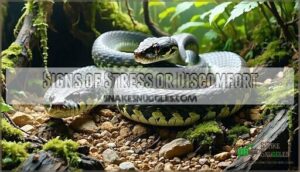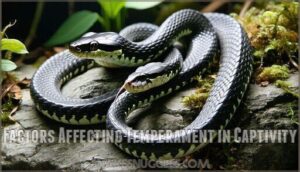This site is supported by our readers. We may earn a commission, at no cost to you, if you purchase through links.
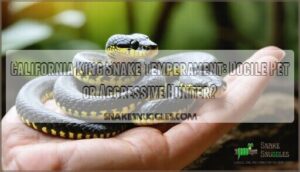
They adapt quickly to handling and remain manageable throughout their lives. Individual personalities vary, but most demonstrate consistent temperaments that respond positively to respectful interaction. Their defensive behaviors include body flattening, hissing, and releasing musky scent when threatened, but these reactions decrease with proper handling.
Understanding their natural behaviors and providing secure environments helps maintain their naturally peaceful disposition.
Table Of Contents
- Key Takeaways
- What is The Temperament of a California Kingsnake?
- Natural Behaviors and Defensive Mechanisms
- Handling and Socialization Tips
- Creating a Suitable Habitat for Calmness
- Factors Affecting Temperament in Captivity
- Frequently Asked Questions (FAQs)
- How often should a California Kingsnake be handled?
- Can California Kingsnakes be housed together?
- What is the average cost of a California Kingsnake?
- Do California Kingsnakes require any special vaccinations?
- Are California Kingsnakes prone to any specific diseases or illnesses?
- Do California kingsnakes bite during handling sessions?
- How long before new kingsnakes adjust properly?
- Can multiple California kingsnakes live together safely?
- What age produces the calmest temperament?
- Do kingsnakes recognize their owners over time?
- Conclusion
Key Takeaways
- You’ll find California kingsnakes are naturally docile – they’re surprisingly calm compared to other snake species and handle regular human interaction well, making them excellent pets for both beginners and experienced keepers.
- You can expect consistent, gentle behavior – while individual personalities vary, most California kingsnakes demonstrate predictable temperaments that respond positively to respectful handling and rarely show aggression toward humans.
- You’ll need to understand their defensive responses – when threatened, they’ll flatten their bodies, hiss, and release musky scents, but these reactions decrease significantly with proper handling and secure environments.
- You can build trust through proper care – providing adequate hiding spots, climbing structures, consistent feeding schedules, and gentle handling sessions helps maintain their naturally peaceful disposition throughout their lives.
What is The Temperament of a California Kingsnake?
You’ll find that California kingsnakes are remarkably docile creatures compared to other snake species of similar size.
These adaptable reptiles handle regular human interaction well and usually remain calm during gentle handling, making them excellent choices for both beginners and experienced snake keepers.
Typical Personality Traits
Your California kingsnake displays naturally docile behavior that makes handling easy for beginners. Their calm temperament shows notable adaptability to different interaction styles, though individual variation exists between snakes.
Most California kingsnakes demonstrate consistent, gentle behavior during regular handling sessions. This docile nature stems from their evolved temperament, making California Kingsnake Care straightforward compared to more defensive species.
Comparison to Other Pet Snakes
Kingsnakes stand out among similar species through their unique temperament variations and behavior patterns. Unlike corn snakes, they’re more active explorers with stronger feeding responses, making handling ease slightly more challenging.
Ball pythons offer better beginner friendliness with their calm nature, while kingsnakes require more respect during interactions. Their care complexity remains moderate, but enclosure needs include secure setups due to their escape-artist tendencies.
In contrast to corn snakes, kingsnakes are known to be ophiophagous snake eaters.
Myths Vs. Reality
Despite wild claims about aggression misconceptions, California kingsnakes have earned their docile reputation through countless gentle handling experiences.
The bite reality? These snakes rarely bite defensively, contradicting kingsnake myths about aggressive temperament.
While wild by nature, proper kingsnake behavior shows they’re naturally calm, unlike some milk snake behavior patterns that appear more defensive.
Natural Behaviors and Defensive Mechanisms
You’ll notice your California kingsnake displays several key behaviors that reflect its wild instincts, even in captivity.
When threatened, it’ll flatten its body, hiss loudly, and may release a musky scent to ward off potential dangers.
Activity Levels and Exploration
Your snake’s natural curiosity drives constant exploration throughout its enclosure. Understanding kingsnake behavior reveals their active temperament and climbing behavior patterns. Here’s what you’ll observe:
- Activity Patterns – They’re most active during dawn and dusk periods
- Natural Curiosity – Investigating every corner, crevice, and new object thoroughly
- Climbing Behavior – Utilizing branches, rocks, and vertical surfaces regularly
Enclosure enrichment promotes exploration benefits by providing varied textures and hiding spots. This milk snake behavior demonstrates their intelligent, inquisitive nature rather than aggressive tendencies.
Common Defensive Responses
When your snake feels threatened, you’ll observe several key defensive mechanisms. Defensive hissing acts as the first warning, followed by body flattening to appear larger. Tail shaking mimics rattlesnakes, while musky odor release creates an unpleasant deterrent. Strike potential increases during stress, but these behavior patterns indicate normal temperament responses requiring careful handling consideration. To guarantee their well-being, it’s also important to take into account their heating and temperature needs.
| Defensive Response | What You’ll See |
|---|---|
| Hissing & Striking | Quick warning bites, loud hissing sounds |
| Body Language | Flattened posture, S-shaped coiling, tail vibration |
| Chemical Defense | Strong musky smell, possible waste release |
Climbing and Hiding Habits
Your kingsnake’s tree-climbing instincts reveal their arboreal behavior in action. They’ll use climbing structures and hiding places throughout their enclosure to satisfy natural instincts and security needs.
This behavior shows a healthy temperament, as they explore habitat complexity for enclosure enrichment. Multiple levels and secure retreats help them feel safe while displaying their natural climbing abilities.
Handling and Socialization Tips
You’ll find that proper handling techniques make the difference between a calm, trusting snake and a defensive one that might bite or musk.
Start with slow movements and short sessions to build your California kingsnake’s confidence, watching for stress signals like rapid breathing or defensive posturing.
Building trust with slow movements and short handling sessions helps prevent your California kingsnake from showing stress signals like rapid breathing or defensive posturing
How to Safely Handle California Kingsnakes
Always support your California kingsnake’s body when lifting. Use proper grip techniques, supporting both the head and midsection.
Captive-bred snakes usually show calmer behavior than wild specimens. Children handling should occur only with adult supervision.
Start with brief sessions to gauge temperament, then gradually increase handling frequency as your snake becomes comfortable with gentle handling interactions. Some owners opt for added safety and security during handling.
Building Trust Through Gentle Interaction
Over time, consistent gentle handling builds trust with your California kingsnake. Start with brief five-minute sessions every few days, using positive reinforcement through calm behavior and temperament recognition.
Gradual introduction prevents overwhelming your snake while avoiding stressors like sudden movements. Watch for signals indicating comfort levels during handling frequency adjustments, strengthening your bond naturally.
To guarantee safety, always prioritize ethical snake handling practices.
Signs of Stress or Discomfort
When your snake shows stress signals, you’ll notice hissing and striking, appetite changes, or erratic movements. Excessive hiding beyond normal behavior indicates discomfort.
During scale shedding periods, temperament shifts and handling sensitivity increases.
Watch for respiratory infection symptoms like mouth bubbling. These behavioral changes signal your snake needs environmental adjustments or veterinary attention.
Creating a Suitable Habitat for Calmness
You’ll create a calm environment for your California kingsnake by providing the right enclosure setup, which directly affects their stress levels and overall temperament. A well-designed habitat with proper hiding spots, climbing structures, and consistent heating helps your snake feel secure and reduces defensive behaviors.
Enclosure Size and Setup
Your California kingsnake needs proper enclosure dimensions to thrive. A 40-gallon reptile terrarium provides adequate space for adults. Choose safe substrate choices like aspen bedding or coconut coir. Maintain temperature gradient from 70-85°F with humidity control at 40-60%. Your snake enclosure becomes their sanctuary with thoughtful setup.
Essential enclosure requirements:
- Spacious reptile enclosure allowing full-body movement
- Clean, dry substrate for comfort and hygiene
- Temperature gradient creating warm and cool zones
- Proper ventilation preventing respiratory issues
- Water dish maintaining ideal humidity levels
Importance of Hiding Spots and Climbing Structures
Your kingsnake’s behavior and temperament improve dramatically with proper hiding places and climbing structures. Fake caves provide security needs while reducing stress levels.
These enrichment benefits promote natural behavior patterns and exercise promotion. Strategic placement of hiding spots helps your snake feel secure, encouraging exploration. Climbing structures support their instinctive behaviors, creating a calmer, more confident pet.
Using Heating Pads Like The VIVOSUN Reptile Heating Pad
When selecting heating pads for your California kingsnake, proper placement creates the essential thermal gradient these reptiles need. The VIVOSUN Reptile Heating Pad offers reliable heat distribution when positioned under one-third of your enclosure.
A thermostat is vital to prevent overheating hazards and maintain a safe temperature range. Always use thermostat control to maintain your snake’s preferred temperature range and prevent burns.
- Pad placement under substrate creates natural belly heat
- Temperature gradient lets your snake self-regulate comfort
- Burn prevention through thermostat control keeps pets safe
- Pad lifespan extends with proper heating and lighting balance
Factors Affecting Temperament in Captivity
You’ll find that your California kingsnake’s temperament in captivity depends heavily on three key factors: consistent feeding schedules, proper environmental conditions, and regular tank maintenance.
When you maintain stable temperatures, provide adequate hiding spots, and keep stress levels low through routine care, you’ll see a calmer, more predictable snake that interacts well and displays its naturally docile nature.
Impact of Diet and Feeding Routine
Your snake’s feeding habits directly shape its temperament. Irregular feeding frequency creates food-driven aggression, while consistent feeding schedules promote calm behavior.
Proper prey size prevents regurgitation and reduces stress. Overfeeding leads to obesity risks and lethargy, while underfeeding increases defensive responses.
Nutritional deficiencies from poor diet quality can trigger behavioral changes, making your snake more irritable. Careful planning of the snake’s dietary needs is thus essential.
Health and Environmental Stressors
Your kingsnake’s health directly impacts its temperament. Respiratory infections from improper humidity levels cause labored breathing and increased aggression. Shedding problems from dry conditions create discomfort, making snakes defensive. Substrate concerns like cedar shavings irritate respiratory systems. Regurgitation causes stress from overfeeding or handling after snake feeding.
Monitor these reptile health factors carefully. Providing adequate reptile hiding places can substantially reduce stress.
Importance of Regular Maintenance
Regular maintenance is key to keeping captive snakes calm and well-adjusted. Weekly enclosure cleaning, proper substrate management, and humidity control directly impact your kingsnake’s temperament and behavior.
During routine cleaning sessions, monitor your snake’s health, assist with shedding when needed, and maintain consistent handling schedules. A well-maintained environment reduces stress, promoting the docile nature that makes these snakes excellent pets.
Proper reptile habitat maintenance includes regular disinfection.
Frequently Asked Questions (FAQs)
How often should a California Kingsnake be handled?
You’ll want to handle your California kingsnake 2-3 times per week, keeping sessions to 10-15 minutes. This frequency maintains their docile temperament while preventing stress from overhandling.
Can California Kingsnakes be housed together?
Approximately 95% of kingsnake conflicts result from territorial disputes. You shouldn’t house California kingsnakes together because they’re naturally cannibalistic and will attack, stress, or even eat cage mates, regardless of size differences.
What is the average cost of a California Kingsnake?
You’ll usually pay between $50-$150 for a baby California kingsnake, depending on the morph and breeder.
Captive-bred specimens range from around $59 to $150, with common morphs costing less than rare color variations.
Do California Kingsnakes require any special vaccinations?
You don’t need to give your California kingsnake any vaccinations. Unlike dogs and cats, snakes don’t require routine shots for disease prevention. Just maintain proper habitat conditions and hygiene.
Are California Kingsnakes prone to any specific diseases or illnesses?
Like a car needing regular maintenance checks, your California kingsnake faces specific health challenges. You’ll watch for respiratory infections from temperature swings and regurgitation from improper handling or oversized meals.
Do California kingsnakes bite during handling sessions?
California kingsnakes rarely bite during handling sessions. Their docile nature makes them tolerate regular interaction well. Gentle, confident movements reduce any chance of defensive biting behavior.
How long before new kingsnakes adjust properly?
Most kingsnakes settle into their new home within two to four weeks. You’ll notice they’re comfortable when they start eating regularly and exploring their enclosure confidently without excessive hiding.
Can multiple California kingsnakes live together safely?
Before the telegraph changed everything, snake keepers learned the hard way that you shouldn’t house multiple kingsnakes together.
These snakes will eat each other due to their snake-eating nature, creating stress and potential cannibalism risks.
What age produces the calmest temperament?
You’ll find the sweetest temperament in young adults around 2-3 years old. They’ve outgrown juvenile skittishness but haven’t developed territorial behaviors yet.
This age strikes the perfect balance between curiosity and calmness for handling.
Do kingsnakes recognize their owners over time?
Your snake’s blank stare might fool you, but these reptiles do recognize familiar scents and vibrations.
Snakes perceive their owners primarily through scent and vibrations, creating a practical awareness rather than emotional attachment.
Conclusion
Like a gentle giant wrapped in beautiful scales, California kingsnakes prove that appearances can be deceiving.
Understanding what’s the temperament of a California king snake reveals these reptiles make excellent pets for both beginners and experienced keepers. They’re naturally calm, handle interaction well, and rarely display aggression toward humans.
With proper care, secure housing, and respectful handling, you’ll discover these snakes maintain their docile nature throughout their lives, making them rewarding companions.

